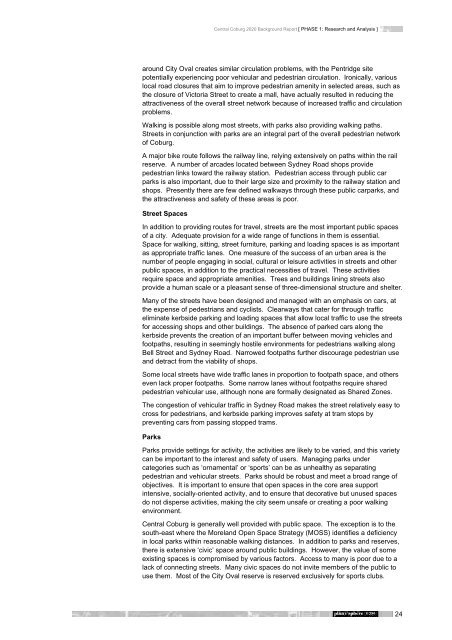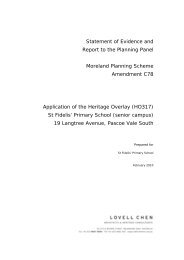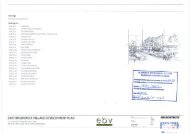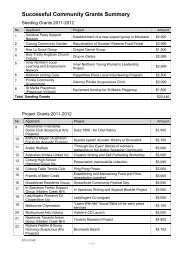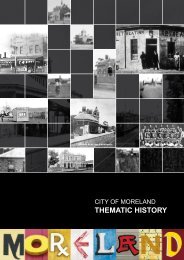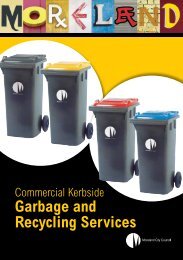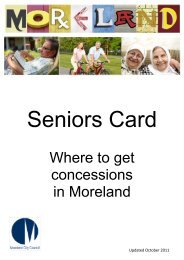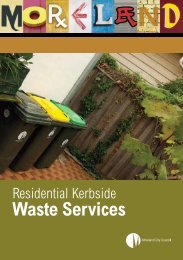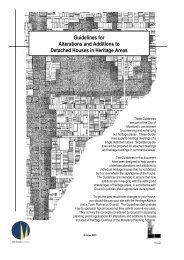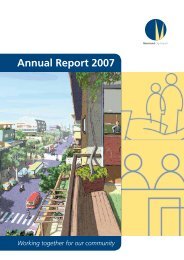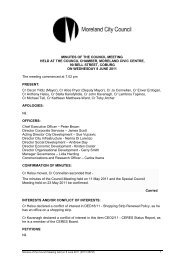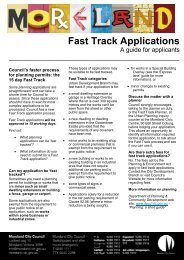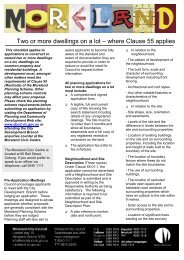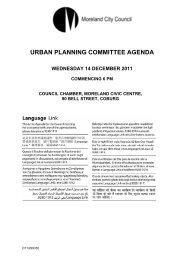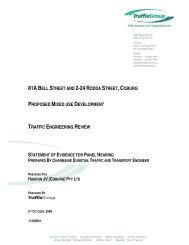Local Planning Policy Framework - Moreland City Council
Local Planning Policy Framework - Moreland City Council
Local Planning Policy Framework - Moreland City Council
Create successful ePaper yourself
Turn your PDF publications into a flip-book with our unique Google optimized e-Paper software.
Central Coburg 2020 Background Report [ PHASE 1: Research and Analysis ]<br />
around <strong>City</strong> Oval creates similar circulation problems, with the Pentridge site<br />
potentially experiencing poor vehicular and pedestrian circulation. Ironically, various<br />
local road closures that aim to improve pedestrian amenity in selected areas, such as<br />
the closure of Victoria Street to create a mall, have actually resulted in reducing the<br />
attractiveness of the overall street network because of increased traffic and circulation<br />
problems.<br />
Walking is possible along most streets, with parks also providing walking paths.<br />
Streets in conjunction with parks are an integral part of the overall pedestrian network<br />
of Coburg.<br />
A major bike route follows the railway line, relying extensively on paths within the rail<br />
reserve. A number of arcades located between Sydney Road shops provide<br />
pedestrian links toward the railway station. Pedestrian access through public car<br />
parks is also important, due to their large size and proximity to the railway station and<br />
shops. Presently there are few defined walkways through these public carparks, and<br />
the attractiveness and safety of these areas is poor.<br />
Street Spaces<br />
In addition to providing routes for travel, streets are the most important public spaces<br />
of a city. Adequate provision for a wide range of functions in them is essential.<br />
Space for walking, sitting, street furniture, parking and loading spaces is as important<br />
as appropriate traffic lanes. One measure of the success of an urban area is the<br />
number of people engaging in social, cultural or leisure activities in streets and other<br />
public spaces, in addition to the practical necessities of travel. These activities<br />
require space and appropriate amenities. Trees and buildings lining streets also<br />
provide a human scale or a pleasant sense of three-dimensional structure and shelter.<br />
Many of the streets have been designed and managed with an emphasis on cars, at<br />
the expense of pedestrians and cyclists. Clearways that cater for through traffic<br />
eliminate kerbside parking and loading spaces that allow local traffic to use the streets<br />
for accessing shops and other buildings. The absence of parked cars along the<br />
kerbside prevents the creation of an important buffer between moving vehicles and<br />
footpaths, resulting in seemingly hostile environments for pedestrians walking along<br />
Bell Street and Sydney Road. Narrowed footpaths further discourage pedestrian use<br />
and detract from the viability of shops.<br />
Some local streets have wide traffic lanes in proportion to footpath space, and others<br />
even lack proper footpaths. Some narrow lanes without footpaths require shared<br />
pedestrian vehicular use, although none are formally designated as Shared Zones.<br />
The congestion of vehicular traffic in Sydney Road makes the street relatively easy to<br />
cross for pedestrians, and kerbside parking improves safety at tram stops by<br />
preventing cars from passing stopped trams.<br />
Parks<br />
Parks provide settings for activity, the activities are likely to be varied, and this variety<br />
can be important to the interest and safety of users. Managing parks under<br />
categories such as ‘ornamental’ or ‘sports’ can be as unhealthy as separating<br />
pedestrian and vehicular streets. Parks should be robust and meet a broad range of<br />
objectives. It is important to ensure that open spaces in the core area support<br />
intensive, socially-oriented activity, and to ensure that decorative but unused spaces<br />
do not disperse activities, making the city seem unsafe or creating a poor walking<br />
environment.<br />
Central Coburg is generally well provided with public space. The exception is to the<br />
south-east where the <strong>Moreland</strong> Open Space Strategy (MOSS) identifies a deficiency<br />
in local parks within reasonable walking distances. In addition to parks and reserves,<br />
there is extensive ‘civic’ space around public buildings. However, the value of some<br />
existing spaces is compromised by various factors. Access to many is poor due to a<br />
lack of connecting streets. Many civic spaces do not invite members of the public to<br />
use them. Most of the <strong>City</strong> Oval reserve is reserved exclusively for sports clubs.<br />
24


